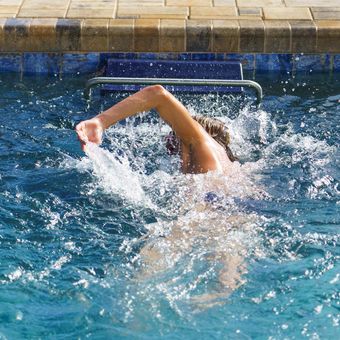5 Tips to Diminish Your Swimming Fear by using a Controlled Environment
By Jenni Brozena, MS, CSCS, CES
Owner/President of Aqueous
For many triathletes, “swim, bike, run” would sound much better as “bike and run as far away from the swim as humanly possible”. The evolution of becoming a triathlete often begins with an athlete as a runner who later turned cyclist (normally when injuries make cross-training sound like a good idea), and then eventually it seemed silly to not conquer the swim as well. Voilà! A triathlete is born.
The adrenaline rush comes from conquering a new sport, a new training regimen, and ultimately completing the rigor of any triathlon distance. Triathletes who are not seasoned competitive swimmers can interpret the swim not only as the most challenging part of the race but a fear-evoking event.
To a novice triathlete, the sheer size of a swimming pool can be intimidating. The length of a lane does not bring much comfort either. (Proposal: as a nice gesture to those truly fearful of swimming, don’t take them to a 50-meter pool their first time.)
The question is not how can we help triathletes avoid their fear while training and racing the swim, but rather what can we teach during training to instill confidence and overcome their fear of the swim.
A controlled swimming atmosphere, like that of an Endless Pools® model, creates an non-intimidating environment. It also provides an opportunity to develop finely tuned motor control skills that greatly impact the triathlete’s swimming performance.
It is common for triathletes to experience heaviness in their legs while they swim; we may even see their hips drop in the water and their legs inch towards a vertical position rather than a force-producing horizontal position. This leads to an increase in energy expenditure, a “fighting” feeling against the water, and an irking feeling to a fearful swimmer that they might not make it to the swim’s endpoint.
How can we help decrease the fear of the swimmer while also improving their kick? Here are five simple steps:
Keep the Endless Pools current off and coach the fearful athlete to float on their back and perform deep diaphragmatic breaths to calm them down and create supportive buoyancy within their core.
Coach the athlete to rotate and float on their stomach with their arms overhead while practicing full exhalations. This will aid in buoyancy, assist in body awareness (proprioception), and guide the legs into a natural horizontal position.
Have the athlete hold onto the handle at the front of the current generator and turn the current on slowly. Instruct the athlete to maintain their breathing pattern and begin to focus their attention to their hip complex.
Cue their attention to focus on extending and flexing at the hip, not the knee.
Increase the speed of the current to support a full kick which originates from the core, gathers most of the force-production capabilities from the hip complex, and carries out propulsion through the entire leg.
Keep the adrenaline rush for the race! Use the controlled atmosphere of an Endless Pools model to refine motor movement, swimming skills, and gain confidence so you neither run nor bike far away from the swim!
About: Jenni Brozena is an international sport scientist and Owner/President of Aqueous, an international organization empowering actionable engagement between aquatic athletes, sport science, human performance, and healthcare. Aqueous is dedicated to the deliberate treatment of aquatic athletes through the performance continuum including preparation, performance, and rehabilitation.

